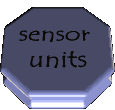![]() What is Sensor?
What is Sensor?
A Sensor is a device, which responds to an input quantity by generating a functionally related output usually in the form of an electrical or optical signal.
During the past two decades, there has
been an unprecedented growth in the number of products and services, which
utilise information gained by monitoring and measuring using different types of
sensors. The development of sensors to meet the need is referred to as sensor
technology and is applicable in a very broad domain including the environment,
medicine, commerce and industry. Governments and policy makers throughout the
work are realising the potential benefits of encouraging the growth in sensor
technology not only as a result of new technological trends, and hence new
products, for the indigenous industry to effect improved product quality and
efficiency by broadening the level of control over their processes, but also in
support of the implementation and enforcement of government legislation on
environmental and safety issues. Such awareness has been copiously demonstrated
in the recent UK national Technology Foresight exercise conducted to examine
potential opportunities and to promote wealth creation and enhance quality.
Through the 15 independent Technology Foresight panels, covering a wide range of
industrial sectors, the worldwide need for sensor technology was reinforced. In
13 out of 15 panels, sensor technology was seen as an integral element in the
overall development of products and services. In fact it emerged as the key
technology to support a wide variety of research and industrial applications.

I
n Pyro, each robot has a set of customizable sensor units. Each sensor has a setting called, units that specifies the units used in reporting sensor values. There are six choices of units:
METERS: The values reported by sensors are in
meters.
CM: The values reported are in centimeters.
MM: The values reported are in
millimeters.
SENSOR
ROBATS: The
values reported are in proportion to the robot's physical diameter. Thus a
distance equal to the robot's diameter is 1.
RAW: The values reported are the raw values from the sensors.